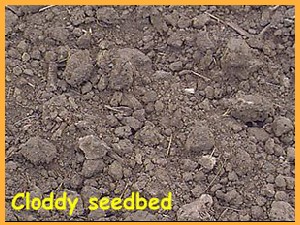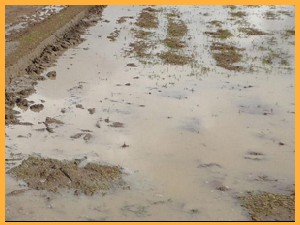Posted: March 31, 2017
The weather is warming up and April is almost here! With that many of us are going to start digging out our tillage equipment to warm up and dry out the soil for planting. There are a few things I would like us to keep in mind when the weather starts to get us excited to get out into the field!
1. Tillage when soil conditions are too wet will cause compaction and soil clods.
 Compaction and clods will plague you throughout your entire crop year. This picture from Mississippi State University shows wheel tracks that were made in the spring, as you can see the color of the corn has a yellow tint to it indicating Nitrogen uptake is impeded. The reason for this is the roots are searching for usable N in the soil, when roots grow down they use the air pores in the soil as a road. Compaction crushes the pores in your soil and makes the plant use more force to push through the compacted areas. If the root cannot get through the soil by going straight down it will begin to travel laterally until it finds a soft enough spot to again grow down to find the needed nutrients. There are several reasons this will impede your end of season yield. One is the number of kernels around and the length of the cob is determined by V8 which can be about one foot tall corn! If we short our corn on nutrients at the beginning of the year it can have negative yield effects at harvest. The second reason we want our plants, especially corn, to be even at the beginning of the year is we need all the plants at the beginning of the year to be the same size so they can all capture an equal amount of sunlight keeping them evenly sized. Dwarfed plants get behind early in the growing season and they will not be able to capture as much sunlight making them smaller and less able to capture the same amount of sunlight on their leaves, as we know sunlight is essential in photosynthesis. Breaking it down into an economic sense why would we want a plant out there that wasn't going to meet its full potential when we paid for the seed, plus the negative yield impact at the end of the year.
Compaction and clods will plague you throughout your entire crop year. This picture from Mississippi State University shows wheel tracks that were made in the spring, as you can see the color of the corn has a yellow tint to it indicating Nitrogen uptake is impeded. The reason for this is the roots are searching for usable N in the soil, when roots grow down they use the air pores in the soil as a road. Compaction crushes the pores in your soil and makes the plant use more force to push through the compacted areas. If the root cannot get through the soil by going straight down it will begin to travel laterally until it finds a soft enough spot to again grow down to find the needed nutrients. There are several reasons this will impede your end of season yield. One is the number of kernels around and the length of the cob is determined by V8 which can be about one foot tall corn! If we short our corn on nutrients at the beginning of the year it can have negative yield effects at harvest. The second reason we want our plants, especially corn, to be even at the beginning of the year is we need all the plants at the beginning of the year to be the same size so they can all capture an equal amount of sunlight keeping them evenly sized. Dwarfed plants get behind early in the growing season and they will not be able to capture as much sunlight making them smaller and less able to capture the same amount of sunlight on their leaves, as we know sunlight is essential in photosynthesis. Breaking it down into an economic sense why would we want a plant out there that wasn't going to meet its full potential when we paid for the seed, plus the negative yield impact at the end of the year.
2. Clods will lead to uneven planting depth and uneven emergence.
 Uneven emergence leads to different plant sizes as we discussed above. In my years in research I was able to experience a variety of tillage practices. The tillage practice that was irreversible the entire year was wet tillage. Tillage when the soil is wet causes clods to form. A clod is a really hard chunk of soil that is tough to break up. In fact the worst clods I have seen have been tough for me to break up with my hands. These clods will last the ENTIRE year! Take a look at the picture and imagine planting into this soil, even with trash whips there are still clods in the soil that will make planting depth nearly impossible to keep consistent. A nice consistently textured seed bed is the best kind of soil to plant into. Next think of the mechanics of how the plant emerges from the soil. If there is a clod that fall directly on top of a plant it will need to do a lot of bending to get that leaf tissue out from under the clod. Equally an uneven stand.
Uneven emergence leads to different plant sizes as we discussed above. In my years in research I was able to experience a variety of tillage practices. The tillage practice that was irreversible the entire year was wet tillage. Tillage when the soil is wet causes clods to form. A clod is a really hard chunk of soil that is tough to break up. In fact the worst clods I have seen have been tough for me to break up with my hands. These clods will last the ENTIRE year! Take a look at the picture and imagine planting into this soil, even with trash whips there are still clods in the soil that will make planting depth nearly impossible to keep consistent. A nice consistently textured seed bed is the best kind of soil to plant into. Next think of the mechanics of how the plant emerges from the soil. If there is a clod that fall directly on top of a plant it will need to do a lot of bending to get that leaf tissue out from under the clod. Equally an uneven stand.
3. Compaction equals crushed pore space, small pore space equals pore drainage.
 If we lived in a perfect world we would have a soil that was 45% mineral matter, 25% air space, 25% water, and 5% organic matter. We unfortunately do not live in a perfect world, and we do not all have an ideal soil type to work with. That is why keeping compaction to a minimum is important. The reason a clay soil will hold water so much better than a sandy soil is the clay has such a tiny little pore space and sand has very large spaces. When we attempt tillage and the soil conditions are on the wetter side the soil structure is crushed, and equates to soils that have very little pore space. You might be thinking that’s great, my soil will be able to hold water way better and I won’t have to worry so much if the weather turns dry. While I wish it worked that way 9 out of 10 times it doesn’t. When water moves into extremely tight spaces in the soil it often times will not come out. That leads to poor drainage like the picture to the right. In fact there are soils in Africa that will permanently remain hard and impermeable if they get wet! While the freeze thaw action will help break up some of this compaction it will not do nearly as much as we would like it too.
If we lived in a perfect world we would have a soil that was 45% mineral matter, 25% air space, 25% water, and 5% organic matter. We unfortunately do not live in a perfect world, and we do not all have an ideal soil type to work with. That is why keeping compaction to a minimum is important. The reason a clay soil will hold water so much better than a sandy soil is the clay has such a tiny little pore space and sand has very large spaces. When we attempt tillage and the soil conditions are on the wetter side the soil structure is crushed, and equates to soils that have very little pore space. You might be thinking that’s great, my soil will be able to hold water way better and I won’t have to worry so much if the weather turns dry. While I wish it worked that way 9 out of 10 times it doesn’t. When water moves into extremely tight spaces in the soil it often times will not come out. That leads to poor drainage like the picture to the right. In fact there are soils in Africa that will permanently remain hard and impermeable if they get wet! While the freeze thaw action will help break up some of this compaction it will not do nearly as much as we would like it too.
I know it’s easy to get excited in the spring, and if the weather stays cool and wet longer than we would like it too, you are better off waiting for soil conditions to shape up than you are to plow ahead into wet soils. Remember early season tillage mistakes will affect you for the entire growing season, and effect your check book for the rest of the year.

 Compaction and clods will plague you throughout your entire crop year. This picture from Mississippi State University shows wheel tracks that were made in the spring, as you can see the color of the corn has a yellow tint to it indicating Nitrogen uptake is impeded. The reason for this is the roots are searching for usable N in the soil, when roots grow down they use the air pores in the soil as a road. Compaction crushes the pores in your soil and makes the plant use more force to push through the compacted areas. If the root cannot get through the soil by going straight down it will begin to travel laterally until it finds a soft enough spot to again grow down to find the needed nutrients. There are several reasons this will impede your end of season yield. One is the number of kernels around and the length of the cob is determined by V8 which can be about one foot tall corn! If we short our corn on nutrients at the beginning of the year it can have negative yield effects at harvest. The second reason we want our plants, especially corn, to be even at the beginning of the year is we need all the plants at the beginning of the year to be the same size so they can all capture an equal amount of sunlight keeping them evenly sized. Dwarfed plants get behind early in the growing season and they will not be able to capture as much sunlight making them smaller and less able to capture the same amount of sunlight on their leaves, as we know sunlight is essential in photosynthesis. Breaking it down into an economic sense why would we want a plant out there that wasn't going to meet its full potential when we paid for the seed, plus the negative yield impact at the end of the year.
Compaction and clods will plague you throughout your entire crop year. This picture from Mississippi State University shows wheel tracks that were made in the spring, as you can see the color of the corn has a yellow tint to it indicating Nitrogen uptake is impeded. The reason for this is the roots are searching for usable N in the soil, when roots grow down they use the air pores in the soil as a road. Compaction crushes the pores in your soil and makes the plant use more force to push through the compacted areas. If the root cannot get through the soil by going straight down it will begin to travel laterally until it finds a soft enough spot to again grow down to find the needed nutrients. There are several reasons this will impede your end of season yield. One is the number of kernels around and the length of the cob is determined by V8 which can be about one foot tall corn! If we short our corn on nutrients at the beginning of the year it can have negative yield effects at harvest. The second reason we want our plants, especially corn, to be even at the beginning of the year is we need all the plants at the beginning of the year to be the same size so they can all capture an equal amount of sunlight keeping them evenly sized. Dwarfed plants get behind early in the growing season and they will not be able to capture as much sunlight making them smaller and less able to capture the same amount of sunlight on their leaves, as we know sunlight is essential in photosynthesis. Breaking it down into an economic sense why would we want a plant out there that wasn't going to meet its full potential when we paid for the seed, plus the negative yield impact at the end of the year. Uneven emergence leads to different plant sizes as we discussed above. In my years in research I was able to experience a variety of tillage practices. The tillage practice that was irreversible the entire year was wet tillage. Tillage when the soil is wet causes clods to form. A clod is a really hard chunk of soil that is tough to break up. In fact the worst clods I have seen have been tough for me to break up with my hands. These clods will last the ENTIRE year! Take a look at the picture and imagine planting into this soil, even with trash whips there are still clods in the soil that will make planting depth nearly impossible to keep consistent. A nice consistently textured seed bed is the best kind of soil to plant into. Next think of the mechanics of how the plant emerges from the soil. If there is a clod that fall directly on top of a plant it will need to do a lot of bending to get that leaf tissue out from under the clod. Equally an uneven stand.
Uneven emergence leads to different plant sizes as we discussed above. In my years in research I was able to experience a variety of tillage practices. The tillage practice that was irreversible the entire year was wet tillage. Tillage when the soil is wet causes clods to form. A clod is a really hard chunk of soil that is tough to break up. In fact the worst clods I have seen have been tough for me to break up with my hands. These clods will last the ENTIRE year! Take a look at the picture and imagine planting into this soil, even with trash whips there are still clods in the soil that will make planting depth nearly impossible to keep consistent. A nice consistently textured seed bed is the best kind of soil to plant into. Next think of the mechanics of how the plant emerges from the soil. If there is a clod that fall directly on top of a plant it will need to do a lot of bending to get that leaf tissue out from under the clod. Equally an uneven stand. If we lived in a perfect world we would have a soil that was 45% mineral matter, 25% air space, 25% water, and 5% organic matter. We unfortunately do not live in a perfect world, and we do not all have an ideal soil type to work with. That is why keeping compaction to a minimum is important. The reason a clay soil will hold water so much better than a sandy soil is the clay has such a tiny little pore space and sand has very large spaces. When we attempt tillage and the soil conditions are on the wetter side the soil structure is crushed, and equates to soils that have very little pore space. You might be thinking that’s great, my soil will be able to hold water way better and I won’t have to worry so much if the weather turns dry. While I wish it worked that way 9 out of 10 times it doesn’t. When water moves into extremely tight spaces in the soil it often times will not come out. That leads to poor drainage like the picture to the right. In fact there are soils in Africa that will permanently remain hard and impermeable if they get wet! While the freeze thaw action will help break up some of this compaction it will not do nearly as much as we would like it too.
If we lived in a perfect world we would have a soil that was 45% mineral matter, 25% air space, 25% water, and 5% organic matter. We unfortunately do not live in a perfect world, and we do not all have an ideal soil type to work with. That is why keeping compaction to a minimum is important. The reason a clay soil will hold water so much better than a sandy soil is the clay has such a tiny little pore space and sand has very large spaces. When we attempt tillage and the soil conditions are on the wetter side the soil structure is crushed, and equates to soils that have very little pore space. You might be thinking that’s great, my soil will be able to hold water way better and I won’t have to worry so much if the weather turns dry. While I wish it worked that way 9 out of 10 times it doesn’t. When water moves into extremely tight spaces in the soil it often times will not come out. That leads to poor drainage like the picture to the right. In fact there are soils in Africa that will permanently remain hard and impermeable if they get wet! While the freeze thaw action will help break up some of this compaction it will not do nearly as much as we would like it too.